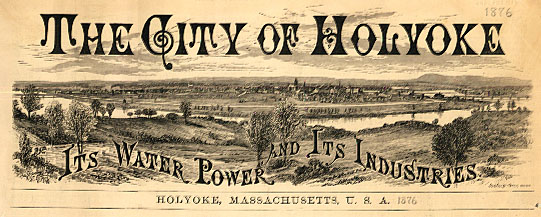The City of Holyoke
Its Water Powers and Its Industries
Holyoke
Incorporated as a Town, March 14, 1850
and as a City, April 7, 1873.
In the pleasantest part of Western Massachusetts, and amidst the choicest river and mountain scenery of the Connecticut Valley, stands the manufacturing city of Holyoke, which this sheet in part illustrates. Its well chosen site rises gradually from the right bank of the river, just below the great rift in the mountain range, where the stream winds between Mt. Holyoke and Mt. Tom, and leaves the more rugged region of the upper valley on its journey through broader meadows and more populous districts to the sea. About one hundred miles from Boston, forty-five more from New York, and mid way between Springfield and Northampton, it lies in the highway of northern travel, and two independent lines of rail bring it in close connection with tidewater, and the railway system of New England and New York.
Whoever attempts to sketch the past and the present of Holyoke, finds little of public interest to chronicle until a time within the memory of the present generation. From time immemorial, the Indians gathered here in great numbers to pursue their fisheries at the great falls of the "Quonektacut," and until within a few years, the "Indian fire-places" dotted the banks now lined with mills, but no traditions have lingered here to make their gathering place famous, and only the frequent relics unearthed by modern changes recall to mind the dusky tribes who resorted hither.
In old colony times, the settlers who came westward from Massachusetts Bay, did not find here the fertile lowlands they were in quest of, and planted the river towns elsewhere along the stream, and even less than thirty years ago, the place where this busy city now stands, was a farming hamlet, sparsely settled and little known. Where a score of families then dwelt in rural quiet, seventeen thousand people are now pursuing all the varied arts and avocations which make up a prosperous manufacturing center.
The sudden growth of Holyoke, and the extent, expansion and variety of its manufactures, have been often noticed in the public prints, but the short period of its existence has been well improved, and it is already a well-ordered, thrifty city, laid out on a large scale, and well filled in with permanent structures, and a stable population. Of course, there is room to build more mills, more shops, more dwellings, and a great domain yet to be utilized as the projectors of the city planned; but what has been done, has been done permanently and well. Churches, schools, hotels, water works, public library; and the other modern essentials of pleasant and healthy town life have kept pace with the rapid increase of population, and in fact, have generally been in advance of the actual demand, being shaped by the generous and far reaching plans of the founders of the place, rather than by the present need; and these, together with the noticeable solidity and extent of the mill-buildings, the commodious tenement-blocks, and the numerous, pleasant, private residences, enable the youngest city in the State to compare favorably with the older manufacturing places in New England in those things which make a location desirable for residence and business.
This great change from fields and farms to mills and city sights and sounds has all been wrought in little more than a quarter of a century; and the moving cause which, in so short a time, has given to the State another flourishing city, to the beautiful Connecticut Valley another object of interest, to manufactures another center, and to the active industry of New England another market, is easily stated. It was not the chance junction of intersecting railways at this point, or the demands of outlying towns for a trading center, or the sudden expansion of some manufacture already established here. It was simply that where the Connecticut River sweeps around the site of Holyoke, the greatest water-power in America, which had been running to waste for centuries over the "Great Rapids," as they had long been called, had finally been made available for manufacturing purposes by a series of magnificent canals and a dam exceeding in dimensions and effect any like structure in the world, —all constructions of great extent and cost and of undoubted permanence. The great factor in the creation and growth of Holyoke, the factor which is destined to multiply its growth over and over again, is the vast, cheap water-power at this point, more than half of which is still running to waste, and waiting to be used on mill-sites as desirable, in every point of view, as those already built upon.
"Printing And Electrotyping By Clark W. Bryan & Co., Springfield
Engraving By Johnson & Dyer, Boston.
Paper Made By Albion Paper Company, Holyoke"
© Laurel O'Donnell 1997 - 2012, all rights reserved
This is an adaptation of the original publication
This document may be downloaded for personal non-commercial use only
and cannot be reproduced or distributed without permission.
|
